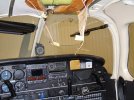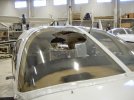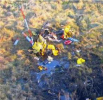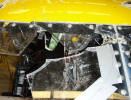Nope. If they come loose, which is really unlikely, the incidence would only change if the eccentrics were rotated, which is even less likely. They're difficult enough to rotate when adjusting the stuff. The adjustment is very, very small anyway, nowhere close enough to cause control difficulties. If the bolt and eccentrics came right out, the wing would tear off instantly. Those bolts are under shear load all the time and would be very difficult to remove in flight, too, even if the nuts weren't there.




